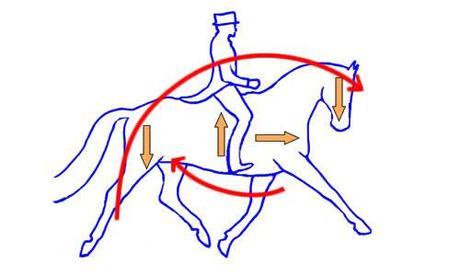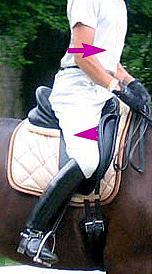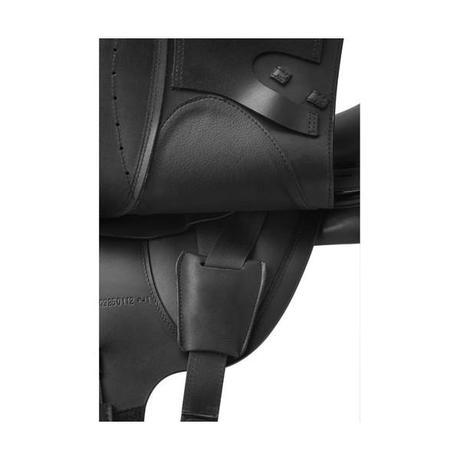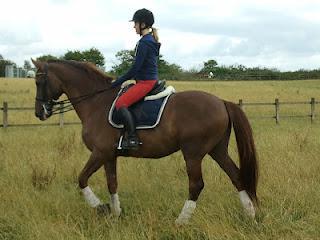The ultimate aim of dressage is for the horse's ribcage, abdominals and back to lift up, bringing the hindquarters underneath him and the forehand up. When you think of what a negative downward-pressing effect the saddle plus your weight has on the horse (which can't be helped because of gravity), we really need a saddle to fit so well that the horse feels he can still lift his back up underneath it without pain or pinching.
A lot of saddles tend to allow the shoulders to be free, enabling expressive forelegs, and good riding can produce an active hind. However, there is an issue is in the back, where a saddle's technology doesn't allow the horse to be fluid through its middle, the bridge that connects the back end to the front end. The result of this disconnection is a weak, undeveloped back and more training issues.
A well-fitting and technically well-designed saddle (like the Prestige D1) allows the horse to use his back as a strong bridge that lets energy flow from the hind legs to the front end. The D1 is designed to be a bit looser around the shoulder so there is more freedom, and the new methods of flocking such as "flair" (air) and "STS" (Soft Touch System) allow the horse to be more comfortable in the back. Also, the saddle should never be fitted exactly too the horse, it should be made a big bigger to allow the horse to expand and fill the space. I absolutely felt like we had a fully built bridge across Seb with the Passier ABS. Immediately he was hotter, quicker to react, and more sensitive to my aids. Why? Because he now had a path for the energy to follow. It's like an electrical circuit which is in series - there must be an unbroken circuit for the electricity to flow through and make a light bulb work. An ill-fitting saddle is the fault in the series circuit that makes all of the christmas tree lights go out, or in other words a horse that can't go "through".

The arrows indicate a "through" horse. Lowering hind quarters,
lifted back, on the bit, forward moving in a cycle.
It is all connected like an electrical circuit in series.
Source
Seb must have been a bit shocked actually. It felt like he could feel his body in a whole new way and start to really use it. He got awfully excited and was very expressive with his legs, bless him. But it was great, because I could plug myself in (again going back to the electrical circuit, your seat is the plug, or the "on" switch) and ride it, rather than try to keep my seat in by gripping with my legs. In all of the previous saddles, I had no choice but to grip with my thighs because otherwise I'd fly out of the saddle. This was the case when I rode in the D1 for 18 months with him, but I didn't realize it was wrong, I just made do with the feeling and did the best I could to make it work. Back then, I thought that because I liked the D1 on other horses, then I should like it on Seb and it should work. Well, no, that is very wrong. So now I am finally relieved of 18 months of gripping for dear life with my thighs. When I told my mom this, she said "oh so that's why you have big muscly thighs!" Hah, funny mother! She was just joking though, but it is a valid explanation... Except really my thighs aren't that big, I'd prefer to describe them as strong ;)
When choosing a saddle, it is always tempting to go for the modern brands with big knee rolls and deep seats because they are comfortable, suck you in and requires less effort to sit correctly. Don't shoot me for saying this if anyone reading has big knee rolls and what not on their saddle, but they don't work. There is proof, trust me! Just read this excerpt from the Sustainable Dressage website:
"By the higher pommel and cantle, the rider sits a lot more secure in the saddle than on the bare back. The higher the pommel and cantle, the sturdier the seat. This extends beyond what is good and useful, and can actually block the correct seat and aids of the rider by "securing" him in a position. These extreme saddles have become very popular lately, and some even have enormous thigh blocks added, without any embarrassement, on the outside of the saddle, not at least trying to hide it under the flap.
This is said to give the rider a firm and plumb seat, and certainly it does. It is just that there is no room to move the legs back and forth to give different aids. There is also no room for different stirrup lengths, which would be useful for riders whose hips are not yet supple enough to be seated without almost any bend in the knee. These bumps push the thigh much further back than most riders, even accomplished ones, are physically agile for. This results in a rotation of the pelvis instead, so that the rider is seated more or less on the crotch.
The plumb position that we are striving for cannot be found with blocks, any more than collection can be found with drawreins. The desired position comes from relaxation and balance, nothing else."
See, told you there was proof. I love the part "and some even have enormous thigh blocks added, without any embarassment, on the outside of the saddle, not at least trying to hide it under the flap".... LOL! The picture they use (below) shows a classic example of what happens when you decide to suck yourself into a saddle. I admit I am guilty of it too. It was only at the beginning of the year I walked into getting a saddle like this, and although it felt easier for me to sit on Seb, I just ended up perching like I was going to lay an egg or something.

Source
So the amazing thing about riding Seb in our new saddle is that all of the aids I was giving before in other saddles, I now need to use a quarter of the strength when I apply them for him to feel it. Honestly, I was just doing anything and everything on top of him to get him to take notice of me. Sometimes I wondered if he even knew he was being ridden. But as soon as I rode a session in the new saddle, I really had to focus on just being still and extremely discreet with my aids, something I really was not used to on him! If I gave him the same strength aid I gave him before, he would completely overreact.
This leads me on to learning how to ride with the advanced technology of such saddles. The air flocked panels make the horse feel the pressure of the rider's weight a quarter of a second later than in a normally flocked saddle. So, bear with me here; If you imagine the point of intersection where the horses hind legs come underneath him, and the point where the horse's movement forces your seat to go heavier down into the saddle (think trot and canter here), without the 1/4sec delay the horse feels your downward pressure sooner when the hind legs are not so far underneath him. But with the 1/4sec delay, the horse's hind legs are able to move further underneath himself because he the air panels stop your weight being pressed down so soon. Are you following? As a result, the horse is obviously able to engage a lot more because the negative effect of the rider's weight is made less negative. Very scientific stuff all this, I must say I was fascinated.

The Prestige D1 Zero saddle technology
Source
This is such an example of how far this sport has come. In the old days (not that I was alive, but I got a taste at Talland where riding the school horses was very much "real riding") you just got on a horse and rode. Leonie said it was amazing to even own a dressage saddle, and if you did you treated it like it was solid gold. Nowadays people deem it crazy to ride dressage in anything but a dressage saddle. That's where I think riding schools like Talland are so valuable these days. They teach you to get on and just ride the horse no matter what saddle. You make it work, preciousness has no role here. Sure, we must consider if the horse is in pain from the saddle or not, but in those days I guess they figured he would soon let you know by either biting when being girthed, bucking, sores or bald patches etc.
Even I got a taste of it on Seb, where I rode him in Leonie's super old Passier which has no knee rolls or anything. Just as long as it wasn't a D1 on him, I could cope. I even remember when I was given an 11.2hh welsh pony to train, and with him came a tiny little County show saddle. Well, it looked like a racing saddle. It was just flat everywhere! And you know what? I actually put it on all my other ponies too, because I loved riding in it! It didn't push me into places my body didn't want to go, and I could ride using my body's own natural biomechanical structure. That is unfortunately short with short legs, slight upper body, narrow hips and not much space between my legs. Those lucky people that have a big gap between their legs can ride in almost anything and still put their leg on. But trust me I can't change it, I've been 42kg and still had no gap between my thighs.
It's a constant battle trying to find the right saddle for a particular horse which fits the rider as well. However I have learnt SO much so far, and now know that no matter what horse I ride, the right saddle for me has to have:
- short flaps so I can feel the horse's sides with my lower leg

The Prestige D1 (here on Julius - it suits him perfectly) has
small enough knee rolls to put my stirrups short when I
want to have a canter in the field.
- a narrow twist tree for my narrow hips, otherwise I might as well be sitting on a table top with no effectiveness from my legs because they cannot hang down correctly.
- no big knee rolls, I would like to be able to put my stirrups at jocket length if I need to, otherwise it's too restricting and blocks the movement of my pelvis.
Do you know what you need in a saddle? Do tall people have less of a problem when it comes to finding a saddle? Post your comment, I'd love to know!

